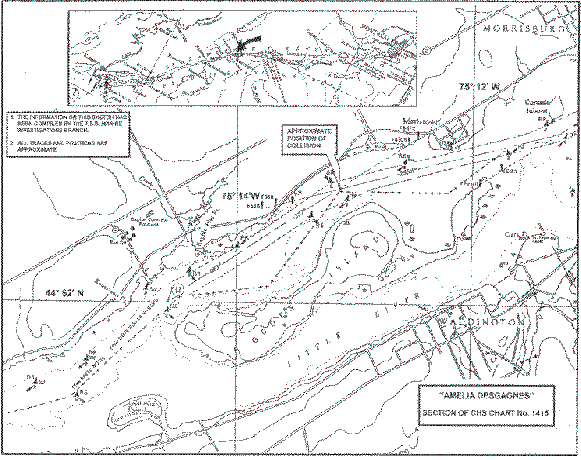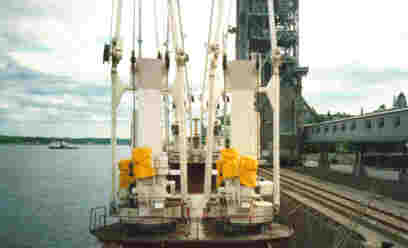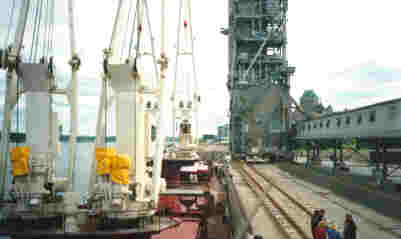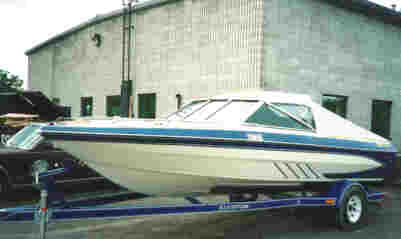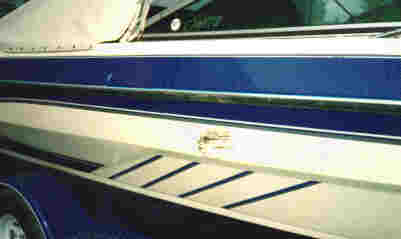Collision between the "AMELIA DESGAGNES"
and the "6E7221"
St. Lawrence Seaway
Morrisburg, Ontario
The Transportation Safety Board of Canada (TSB) investigated this occurrence for the purpose of advancing transportation safety. It is not the function of the Board to assign fault or determine civil or criminal liability. This report is not created for use in the context of legal, disciplinary or other proceedings. See Ownership and use of content. Masculine pronouns and position titles may be used to signify all genders to comply with the Canadian Transportation Accident Investigation and Safety Board Act (S.C. 1989, c. 3).
Summary
On 23 May 1992, at about 1505, the Canadian general cargo vessel "AMELIA DESGAGNES" collided with a Canadian pleasure craft, licence number 6E7221, that had broken down in the channel. Five of the pleasure craft's occupants, who had jumped into the water before the collision, escaped with minor injuries. The slightly damaged boat was towed ashore. The collision occurred in waters along the Canadian/U.S. border in daylight and in good visibility.
The Board determined that the "AMELIA DESGAGNES" and the pleasure craft collided because of an engine malfunction on the pleasure craft. The occupants of the pleasure craft were not able to effectively indicate that they were in distress. Contributing to the collision was the fact that those in charge of the watch on the "AMELIA DESGAGNES" did not maintain an effective look-out.
1.0 Factual Information
1.1 Particulars of the Vessels
| AMELIA DESGAGNES | N/A | |
|---|---|---|
| Official number | 369043 | - |
| Licence Number | - | 6E7221 |
| Port of registry | Quebec, Quebec | - |
| Registry Office | - | Brockville, Ontario |
| Flag Type | Canadian | Pleasure Craft |
| Gross Tons | 4,490 | 5 |
| Length | 108.24 m | 6 m |
| Draught | F2: 7.57 m | - |
| A: 7.75 m | - | |
| Built | 1976 Collingwood, Ontario | 1989 Texas U.S.A |
| Propulsion | 2,942 kW diesel engine driving a single controllable-pitch propeller | 130 HP gasoline inboard/outboard Mercruiser |
| owners | Transports Desgagnes Inc. Quebec, Quebec | G.F. Perrin's Sales and Service Brockville, Ontario |
1 Units of measurement in this report conform to International Maritime Organization (IMO) standards or, where there is no such standard, are expressed in the International System (SI) of units.
2 See Glossary for all abbreviations and acronyms.
3 All times are EDT (Coordinated Universal Time (UTC) minus four hours) unless otherwise stated.
1.1.1 Description of the Vessels
The "AMELIA DESGAGNES" is a three-hold general cargo vessel with a raised forecastle. The machinery space, accommodation and navigation bridge are located aft. There are two sets of deck cranes forward of the bridge.
The "6E7221" is an open fibreglass runabout built by Glastron. The conning position is behind a windshield on the starboard side.
1.2 History of the Voyage
In certain aspects, the testimony of those aboard the "AMELIA DESGAGNES" differed markedly from that of the pleasure craft's occupants.
1.2.1 According to the Navigating Personnel of the "AMELIA DESGAGNES"
On the afternoon of 23 May 1992, the "AMELIA DESGAGNES" was downbound in the St. Lawrence Seaway, carrying a cargo of grain for Québec, Quebec.
At about 15003, the vessel was upstream of buoy 95, steering 057· True (T) and Gyro (G) in the centre of the channel and making a speed of about 11.5 knots (kn) over the ground. The master, who had the conduct of the vessel, saw the "6E7221" overtake the "AMELIA DESGAGNES" to port and disappear behind the fore part of the ship. There had been a great many pleasure craft in the channel that afternoon, and the crew members of the "AMELIA DESGAGNES" paid no particular attention to the "6E7221". They assumed that the "6E7221" would cross their vessel's path ahead and eventually be visible to starboard.
At about 1505, as the "AMELIA DESGAGNES" was between buoys 93 and 95 and initiating an alteration of course to starboard to 075· (T) & (G), the master, who was at a starboard wheel-house window, saw three women and two men swimming in the water close on the vessel's starboard bow. The master shouted to warn them of the danger they were in. At the same time, the officer of the watch (OOW), who was at a window on the port side, saw the stopped "6E7221", with a sole occupant, close on the port bow. A warning blast on the whistle was sounded. The "AMELIA DESGAGNES" sailed between the pleasure craft and the swimmers, passing some three to four metres from them. The master quickly called Seaway Iroquois to advise the staff there of the potential hazard of people swimming in the shipping channel.
The main engine and propeller were not slowed or stopped, nor was emergency equipment deployed. The "AMELIA DESGAGNES" reportedly struck neither the pleasure craft nor the swimmers.
1.2.2 According to the Occupants of the "6E7221"
The operator took possession of the "6E7221" on 22 May 1992. On the afternoon of 23 May, he and five guests took the boat for an outing on the St. Lawrence River.
At about 1500, proceeding on the Canadian side of the river at a speed of approximately 20 kn, the powerboat overtook the "AMELIA DESGAGNES". When the "6E7221" was approximately two or three cables ahead of the ship, the boat's inboard-outboard engine stalled. Attempts to restart the engine were unsuccessful. One of the guests aboard the boat signalled with her arms in an attempt to indicate that they were in distress. The "6E7221" drifted toward the middle of the channel, into the path of the "AMELIA DESGAGNES" as she was beginning to turn to starboard. When the "AMELIA DESGAGNES" was no more than a few metres from the "6E7221", all five guests jumped into the water toward the American shore. The "6E7221" was struck by the ship but remained upright, and the operator remained on board.
A blast of the ship's whistle was heard, and someone from the ship shouted something. After the "AMELIA DESGAGNES" passed, two of the women returned to the "6E7221", climbed aboard and threw three lifejackets into the water to assist the others. The lifejackets were later recovered; the third woman, who was still in the water, had reached one of them before she was rescued. Two pleasure craft from the Canadian shore retrieved the remaining guests from the water and towed the "6E7221" to Mariatown, Ontario.
1.3 Injuries to Persons
No one aboard the "AMELIA DESGAGNES" was injured.
The five guests on the "6E7221" suffered minor scrapes and bruises and mild hypothermia. One guest was reportedly close to drowning.
1.4 Damage
1.4.1 Damage to the "AMELIA DESGAGNES"
At the next lock, Eisenhower, the stem of the "AMELIA DESGAGNES" was examined. No damage or marks were found.
1.4.2 Damage to the "6E7221"
At the deck edge of the "6E7221", a rubber rubbing strip on the starboard side of the hull was abraded over a length of one metre. Immediately below this damage, there was a 125 mm x 125 mm perforation in the boat's white fibreglass hull, in the middle of a 170 mm x 170 mm area of black abrasions. A sample of the black paint in these abrasions and a sample of paint from the bow of the "AMELIA DESGAGNES" were examined at the TSB Engineering Laboratory. It was considered that the similarity found in the analysis "would confirm the presence of the ["AMELIA DESGAGNES"] in an area of contact on the smaller craft and be consistent with collision of the two vessels."
1.5 Certification
1.5.1 Certification of the "AMELIA DESGAGNES"
The "AMELIA DESGAGNES" was manned, certificated and equipped in accordance with the appropriate regulations.
1.5.2 Licence of the "6E7221"
Because the "6E7221" had been intended for the U.S. market, the boat carried a capacity plate showing that the boat met the United States Coast Guard's minimum construction standards and could carry eight persons or 566 kg (1,250 lb.). The boat had been licensed with the Canadian Department of Transport in Brockville, Ontario, on 10 March 1992 by G.F. Perrin's Sales & Service. Ownership had not yet been transferred to the new owner at the time of the occurrence.
1.5.3 Personnel of the "AMELIA DESGAGNES"
The crew members of the "AMELIA DESGAGNES" who were directly involved in this occurrence were properly certificated for the positions they held and for the vessel's trade.
The "AMELIA DESGAGNES" was exempted from compulsory pilotage in the Great Lakes Pilotage Authority region.
1.5.4 Operator of the "6E7221"
The operator of the "6E7221" held no certificate or licence, nor was he required to by regulation.
1.6 Personnel History
1.6.1 Master of the "AMELIA DESGAGNES"
The master had 21 years' sea service, including 12 years as a master. He had been in command of the "AMELIA DESGAGNES" since 06 May 1992, and he had considerable experience on the Seaway.
1.6.2 Officer of the Watch (OOW) of the "AMELIA DESGAGNES"
The second officer, who was the OOW, had 15 years' sea service, including 9 years as a deck officer. He had held his position on the "AMELIA DESGAGNES" since 06 May 1992.
1.6.3 Operator of the "6E7221"
The "6E7221" is the third boat that the operator has owned. The operator had approximately eight years' experience as an amateur pleasure boater, but he had not taken a navigation course and was not familiar with either the International Regulations for Preventing Collisions at Sea (Collision Regulations) or the Canadian buoyage system.
1.7 Weather and Current Information
Both the "AMELIA DESGAGNES" and the Iroquois Lock recorded winds in the south-west quadrant at between 15 and 20 kn. Visibility was good and there was no precipitation.
The Sailing Directions for the Great Lakes, Volume 1, Tenth Edition, advise that the current in the Morrisburg-Iroquois area is reported to often attain a rate of 2 kn. The actual rate of the current at the time of the occurrence could not be determined; however, it was established that the water level was in excess of 0.75 m above chart datum.
1.8 Navigation Equipment
1.8.1 The "AMELIA DESGAGNES"
One of the two radar sets on the "AMELIA DESGAGNES" was in operation; however, as visibility was good, no systematic radar watch was being kept. The vessel is not equipped with a course recorder. The gyrocompass error was deemed negligible.
1.8.2 The "6E7221"
The "6E7221" was not fitted with any specific navigation equipment and was not carrying a marine chart of the area. As required by Rule 33 of the Collision Regulations, the "6E7221" was equipped with a sound signalling appliance in the form of an electrically powered horn; however, because of the power failure, the horn was not operational at the time of the collision.
1.8.3 Aids to Navigation
The "AMELIA DESGAGNES" was steering 057· (T) & (G) on the Mariatown ranges before she initiated an alteration of course to starboard to 075· (T) & (G) and collided with the "6E7221".
1.9 Radio Communications
1.9.1 Inter-Ship
The "6E7221" was not required by regulation to be equipped with a radiotelephone, and she was not so equipped, thus precluding any communication between the vessels.
1.9.2 Seaway Radio Stations
At 1505, shortly after the vessel had cleared the "6E7221" and the people in the water, the master of the "AMELIA DESGAGNES" advised Seaway Iroquois of a potential hazard in the navigation channel.
The Seaway traffic control centre at Saint-Lambert, Quebec, did not request any further details but communicated with Seaway Eisenhower to determine which centre had the proper authority to deal with the situation. It was decided that, since the occurrence was believed to have taken place in U.S. waters, a superintendent from Seaway Eisenhower should attend to it. The Ontario Provincial Police (OPP) was informed of the situation at 1513.
1.10 Emergency Equipment
1.10.1 Life-saving Equipment on the "AMELIA DESGAGNES"
The "AMELIA DESGAGNES" did not use any of the emergency equipment aboard.
1.10.2 Safety Equipment on the "6E7221"
The Small Vessel Regulations require a vessel the size of the "6E7221" to carry safety equipment which includes the alternative of an anchor with line, two oars with rowlocks or two paddles, and a throwable device in the form of an approved lifebuoy, an approved cushion or a buoyant heaving line. The "6E7221" carried one oar, an anchor and a buoyant heaving line. The regulations also require that six pyrotechnic distress signals be carried unless, among other scenarios, the vessel operates on a river no more than one mile from shore, as was the case with the "6E7221" at the time of the occurrence. The "6E7221" was not carrying pyrotechnic distress signals.
Six lifejackets were carried on the "6E7221", but none of the occupants was wearing one at the time of the occurrence.
1.11 Search and Rescue
The shouts of the people in the water attracted the attention of persons on the Canadian shore, who then called the OPP. The OPP arrived within five minutes of having been alerted to find all the occupants of the "6E7221" safely ashore. The ambulance that the OPP had summoned was also on the scene.
First-aid was rendered to the five guests before they were transported to a local hospital, where they were examined and released.
As the crew members aboard the "AMELIA DESGAGNES" believed that the pleasure boaters were swimming, they did not undertake any rescue initiatives.
1.12 Conduct of the Two Vessels
The master of the "AMELIA DESGAGNES", who had the conduct of the vessel, was at a forward wheel-house window on the starboard side, the OOW was standing the watch at a window on the port side, and the helmsman was at the steering station. Navigation was being carried out by visual reference.
The "6E7221" was being navigated downbound on the port side of the main navigation channel. There is an adequate depth of water in this stretch of the Seaway to permit a vessel of this size to operate outside the channel.
1.13 Power Failure on the "6E7221"
On 24 May 1992, the "6E7221" was returned to the vendor, and the battery was replaced after an inspection revealed that it was dead. When the engine was started, the voltmeter on the instrument panel gave a reading of only 12 volts instead of a reading of greater than 14 volts. The circuit breaker of the engine's electric board remained closed. After a new alternator was installed on the inboard-outboard motor, the gauge gave the correct reading.
1.14 Restricted View from the Bridge of the "AMELIA DESGAGNES"
On the "AMELIA DESGAGNES", as on most commercial vessels, there is an area ahead in which the vision of an observer on the bridge is restricted. The situation was aggravated on the "AMELIA DESGAGNES" by the presence of two sets of two deck cranes. Although the booms were lowered, the cabs of the cranes restricted the field of view forward.
For a person at the centre-line conning position, the vertical blind sector between the two sets of cranes extended approximately 190 m beyond the bow, taking into consideration the vessel's trim at the time of the occurrence. Because of this restricted field of vision, the navigating personnel adopted conning and look-out positions on either side of the bridge. The cranes also caused horizontal blind sectors totalling approximately eight degrees. As the "AMELIA DESGAGNES" was an "existing ship" on 02 January 1992, Canadian Coast Guard (CCG) Ship Safety Bulletin No. 3/93 regarding navigation bridge visibility did not strictly apply to her. However, to all intents and purposes, the vessel met the guidelines.
1.15 The Collision Regulations
The convention is for vessels to keep to the starboard side of a channel and for small vessels not to hamper larger vessels that must navigate in it. Rule 9 of the Collision Regulations, which covers vessels in narrow channels, states in part that, "a vessel proceeding along ... a narrow channel ... shall keep ... to the ... limit of the channel ... which lies on her starboard side" and that, "a vessel of less than 20 metres in length ... shall not impede the passage of a vessel which can safely navigate only within a narrow channel...." With respect to keeping a vigilant watch, Rule 5 states, in part, that "every vessel shall at all times maintain a proper look-out ... by all available means ... to make a full appraisal ... of the risk of collision."
1.16 Ship Safety Bulletins
The Ship Safety Branch of the CCG has issued two Ship Safety Bulletins covering the interaction between large and small vessels in areas where vessels meet and are at close quarters: bulletins Nos. 10/87 and 11/88. These bulletins, which are intended to be read together, in part advise "mariners operating smaller vessels" that "it would be dangerous to assume that mariners in charge of larger vessels can always see, appreciate and avoid endangering a smaller vessel." It is further stated that, "in order to avoid a
close-quarters situation it may be necessary for small craft to leave the channel when it is safe to do so." The bulletins report that there have been several serious occurrences, some with loss of life, where small vessels have impeded larger vessels in restricted areas.
2.0 Analysis
2.1 Conduct of the "6E7221"
The pleasure craft was under the conduct of the operator. Although he was an experienced pleasure boat owner, he had not taken any marine navigation courses. Since Canadian pleasure craft owners are not subject to compulsory training, many are unaware of the privileges granted to larger vessels under the Collision Regulations.
There was plenty of water in the area where the collision occurred to allow a vessel of the size and type of the "6E7221" to operate, without danger, outside of the narrow main navigation channel and thus avoid a close-quarters situation. The "6E7221" was being operated within the main navigation channel and was not being kept to the starboard side of the channel.
Had the "6E7221" carried a second oar, the occupants might have had time to paddle the boat out of the centre of the channel.
2.2 Navigational Watch on the "AMELIA DESGAGNES"
Commercial vessels meet many pleasure craft that are being operated in the main navigation channel, often with complete disregard for the personal safety of the boat's occupants. These types of encounters occur with such frequency that the crews of commercial vessels may become complacent about keeping an effective look-out for pleasure craft. Powerboat pleasure craft are normally much faster and more manoeuvrable than larger commercial vessels are, but they are often operated in an erratic and unpredictable manner that makes it difficult to assess whether risk of collision exists.
When the "6E7221" passed ahead of the "AMELIA DESGAGNES" and was lost to sight, the ship's crew members expected that the boat would eventually reappear to starboard, as had several others that day. No particular measures were taken to track the "6E7221".
It was difficult to keep an adequate visual look-out ahead because of the blind sectors caused by the cranes forward of the wheel-house. When the "6E7221" and the occupants who were in the water were passed by the "AMELIA DESGAGNES", the master's interpretation of the situation was reflected in his report to Seaway Iroquois, in which he advised of a pleasure craft stopped in the channel and of people swimming.
Narrow channels offer very little manoeuvring room for large vessels, and it can be risky for such vessels to slacken speed or stop in strong currents and crosswinds. At a speed through the water of 10 kn, the "AMELIA DESGAGNES" would have closed the three cables to the disabled "6E7221" in less than two minutes. Had the presence of the "6E7221" been detected immediately, the "AMELIA DESGAGNES" would have been limited with regard to what action could be taken.
2.3 Pyrotechnic Distress Signals
A strict interpretation of the Small Vessel Regulations reveals that pyrotechnic distress signals were not required by the "6E7221". However, as the use of the horn had been lost and no radiotelephone was on board, the occupants of the "6E7221" could have used a pyrotechnic distress signal to indicate the boat's presence had such an appliance been on board.
2.4 Response to the Emergency
The "AMELIA DESGAGNES" did not report the occurrence as an emergency, and time was lost as the Seaway traffic centres attempted to establish the precise position of the occurrence and ascertain whether it had taken place in U.S. or Canadian waters in order to determine which authorities to advise.
2.5 Pleasure Craft Engine Maintenance
The operator had only recently taken possession of the "6E7221". He had had no apparent problem starting the engine, and he was giving the boat the first meaningful sea trials under his care. The engine's reliability and maintenance needs were, therefore, still being assessed.
3.0 Findings
3.1 Findings
- The "6E7221" suffered an engine breakdown in the main navigation channel, some two to three cables ahead of the "AMELIA DESGAGNES".
- The engine breakdown was subsequently found to be electrical in origin and to have been caused by a malfunctioning alternator.
- Without propulsion, the "6E7221" drifted toward the centre of the channel.
- There was only one oar on the "6E7221". It could have been used to move the pleasure craft out of the channel, but it was not.
- Because of the power failure, the boat's electric horn could not be used to sound a distress signal, and only a visual signal with outstretched arms was given.
- The pleasure craft was not required to be equipped with pyrotechnic distress signals, and none were aboard.
- Because of deck cranes, the "AMELIA DESGAGNES" had a horizontal blind sector of eight degrees and the vertical blind sector between the two sets of cranes extended approximately 190 m beyond the bow.
- The plight of the "6E7221" was not noticed by the crew of the "AMELIA DESGAGNES".
- Five of the six occupants of the "6E7221" jumped into the water before the "AMELIA DESGAGNES" struck the boat.
- To those on the bridge of the "AMELIA DESGAGNES", the first indication of a dangerous situation was the sight of the "6E7221" and of the people in the water passing down the sides of the ship.
- The main propulsion of the "AMELIA DESGAGNES" was not slowed or stopped.
- None of the occupants of the "6E7221" was wearing any form of flotation device.
- The occurrence was reported as a dangerous incident, and precious time was lost in determining jurisdiction.
- The crew members of the "AMELIA DESGAGNES" did not deploy any life-saving equipment because they assumed that the persons in the water were pleasure boaters swimming from the "6E7221".
3.2 Causes
The "AMELIA DESGAGNES" and the pleasure craft collided because of an engine malfunction on the pleasure craft. The occupants of the pleasure craft were not able to effectively indicate that they were in distress. Contributing to the collision was the fact that those in charge of the watch on the "AMELIA DESGAGNES" did not maintain an effective look-out.
4.0 Safety Action
4.1 Safety Concern
4.1.1 Collisions Between Commercial Vessels and Pleasure Craft
In the last 10 years, more than 54 collisions have occurred between pleasure craft and large commercial vessels. Of these accidents, 19 were due to inattention or poor look-out, 15 to poor handling or imprudent action, 9 to reduced visibility, 8 to mechanical failures, and 2 to excessive speed.
The Canadian Coast Guard (CCG) Marine Rescue Centre in Québec City reported that, since 1987, 12 collisions and 14 near-collisions have been reported in that district. In the narrow waterways of the St. Lawrence River and Seaway, the damage that resulted from such occurrences varied from minor scuffs to total loss of the pleasure craft.
In 1987 and 1988, the CCG issued two Ship Safety Bulletins (SSB Nos. 10/87 and 11/88) to warn mariners to avoid close-quarters situations in narrow channels and around harbours. Although the CCG and other non-profit organizations regularly campaign to promote safety, the lack of basic skills and knowledge of seamanship among pleasure craft operators continues to create accident situations.
There is no legal requirement to have an operator's licence to operate pleasure craft in Canada. The CCG recently initiated discussions with the Province of Ontario to establish basic proficiency requirements and mandatory educational training for a pleasure craft operator's licence.
Although commercial shipping has a responsibility to monitor the movements of smaller craft, large ships do not always have sufficient sea room to manoeuvre within narrow channels or fairways. The Board believes that pleasure craft operators continue to put themselves at risk when, by want of skills, lack of knowledge, or through inattentiveness or imprudence, they impede the passage of large commercial vessels.
When a mechanical failure occurs in a restricted channel and the operator of a pleasure craft does not have the necessary means to communicate this situation by radiotelephone or by the use of pyrotechnics to warn oncoming traffic, the risks increase.
In view of the frequency and potential severity of collisions between pleasure craft and large commercial vessels, the Board is concerned that current requirements for ensuring the safety of pleasure boaters are inadequate, particularly with respect to the skills and knowledge required of operators, and to the carriage of emergency, distress and communication equipment. The Board commends such initiatives as that being undertaken by the CCG and the Province of Ontario to establish licensing requirements for operators. Additional measures by the CCG, provincial authorities and non-governmental organizations are encouraged to enhance safety awareness by pleasure boaters.
This report concludes the Transportation Safety Board's investigation into this occurrence. Consequently, the Board, consisting of Chairperson, John W. Stants, and members Gerald E. Bennett, Zita Brunet, the Hon. Wilfred R. DuPont and Hugh MacNeil, authorized the release of this report on .
Appendices
Appendix A - Chart of the Area of Occurrence
Appendix B - Photographs
Appendix C - Glossary
- A
- aft
- CCG
- Canadian Coast Guard
- EDT
- eastern daylight time
- F
- forward
- G
- Gyro (degrees)
- HP
- horsepower
- IMO
- International Maritime Organization
- kg
- kilogram(s)
- kn
- knot(s): nautical mile(s) per hour
- kW
- kilowatt(s)
- lb.
- pound(s)
- m
- metre(s)
- mm
- millimetre(s)
- OOW
- officer of the watch
- OPP
- Ontario Provincial Police
- SI
- International System (of units)
- SSB
- Ship Safety Bulletin
- T
- True (degrees)
- TSB
- Transportation Safety Board of Canada
- U.S.
- United States of America
- UTC
- Coordinated Universal Time
- °
- degree(s)
